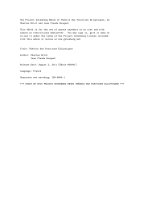Novel methods (sonochemistry, microwave dielectric heating, sonoelectrochemistry and RAPET for the fabrication of nanomaterials and their applications
Bạn đang xem bản rút gọn của tài liệu. Xem và tải ngay bản đầy đủ của tài liệu tại đây (13.29 KB, 2 trang )
Novel Methods (Sonochemistry, Microwave dielectric heating,
Sonoelectrochemistry, and RAPET) for the Fabrication of
Nanomaterials and Their Applications
Aharon Gedanken, Kanbar Laboratory for Nanomaterials at the Bar-Ilan University
Center for Advanced Materials and Nanotechnology,
Bar-Ilan University, Ramat-Gan, 52900, Israel
In my lecture I’ll present the four methods employed in my laboratory for the fabrication
of nanoparticles. The advantages or superiority of the method over the other techniques
used for the synthesis of nanoparticles as well as their application will be presented.
Sonochmistry is a technique in which ultrasonic waves are passed through a solution and
the nanomaterials either precipitate or form a colloidal solution at the end of the
sonication. After preparing about 100 nanostructures by this technique I consider its four
main advantages over other techniques as: 1) Preparation of amorphous products
. Under
certain condition amorphous products are formed. There is no need to add glass formers
and as a bonus the amorphous products are obtained in nanometer size.2) Deposition of
nanoparticles on ceramic and polymeric surfaces. A smooth homogeneous coating layer
is formed on the surface. The nanoparticles are anchored to the surface by forming
chemical bonds or chemical interactions with the substrate and cannot be removed by
washing. We can coat this way surfaces of polymers, ceramics, metals, glasses, textiles,
and carbon bodies. 3) Insertion of nanomaterials into mesoporous materials. and 4) The
formation of proteinaceous micro and nanospheres.
Microwave (MW) MW dielectric radiation is used mostly for the preparation of
nanometals, nanometal oxides, and nanoparticles of metal chalcogenides (S
-2
, Se
-2
, and
Te
-2
). We will show how by using aquatic plants and MW we can clean water wastes
from Heavy metal ions on the one hand, and on the other convert the wastes (silver ions
for example) into marketable metallic nanoparticles.
We have applied recently for a Patent claiming that nanoparticles of MgF
2
prevent the
formation of biofilms. The Magnesium fluoride nanoparticles are prepared using MW
radiation and ionic liquids
The main parameters that determine the particle size in sonoelectrochemistry are
temperature, sonication intensity, and the electric pulse width. Its main synthetic
advantage is the ability to reduce metals for which there is no reducing agent that can do
it. For example, preparing metallic Mg nanoparticles.The last technique was named by us
RAPET. It stands for Reaction under Autogenic Pressure at Elevated Temperatures.
RAPET is being used in our laboratory for the last four years. We will show that the
RAPET of silanes is yielding the smallest reported SiC particles having the highest
surface area. The RAPET of empty Coca Cola bottles yields micron size carbon spheres
with a tensile strength of 8.30±0.69 GPa.









